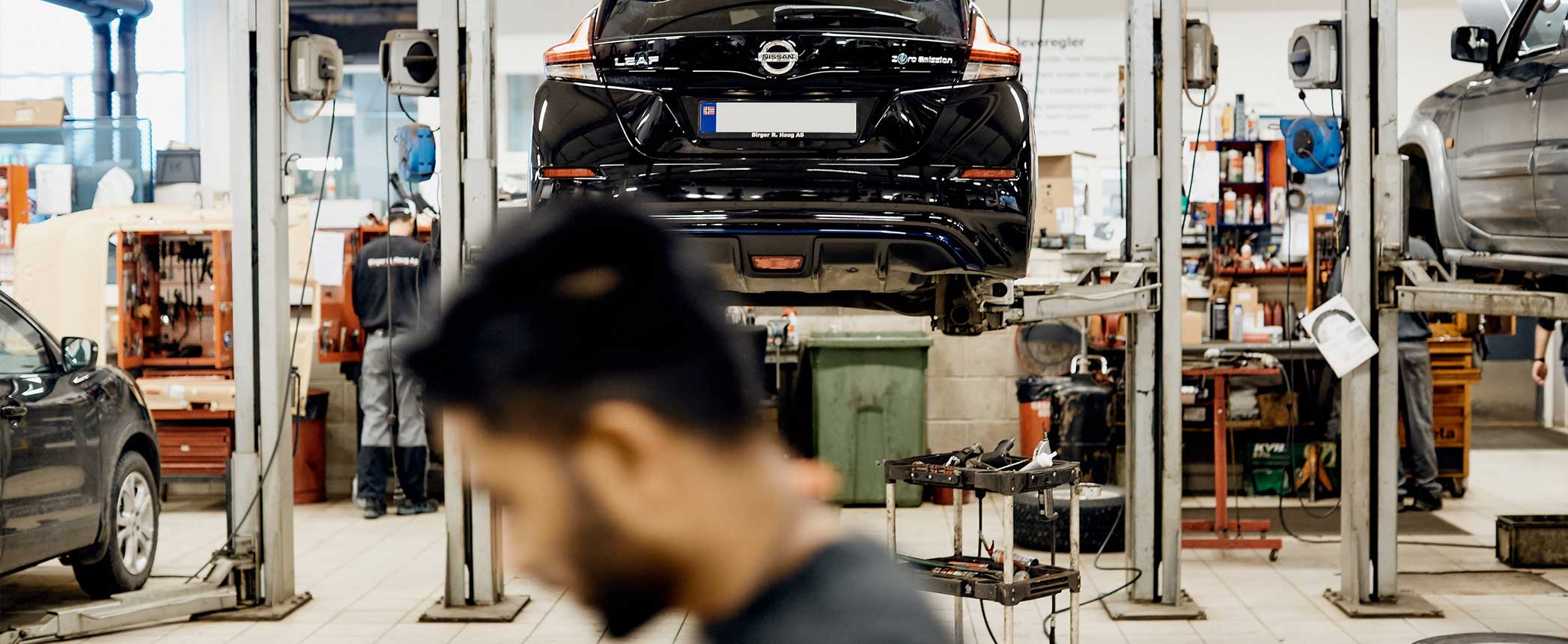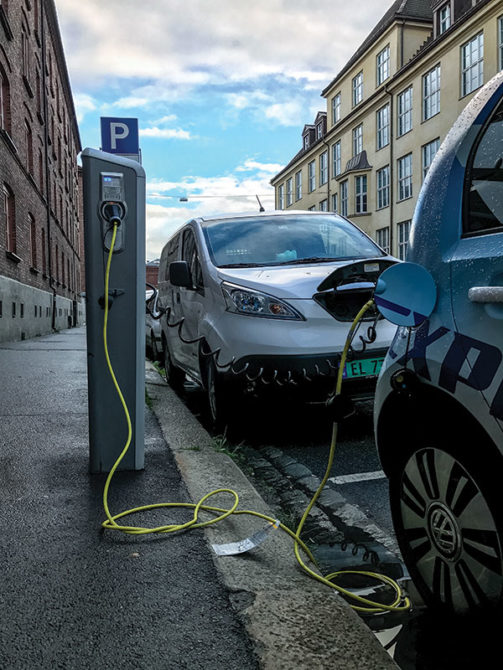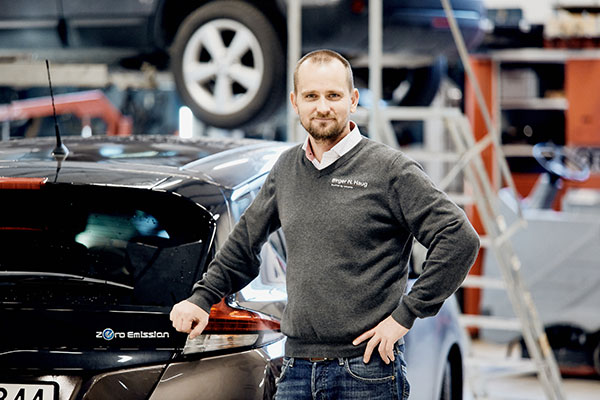
Norway leads Europe in the number of new four-wheel electrified vehicle registrations. The extent of the threat posed by EVs to auto lubes will play out here first.
For people concerned about the impact electric vehicles will have on the lubricants industry, Norway offers a preview. That’s because the Scandinavian country ranks higher than all others both in the number of EVs per capita and in the portion of its passenger car market that is EVs. Lubricant suppliers and auto service providers say they are already seeing the impact, including reduced volumes of automotive lubes, demand for different types of products and a need to change the ways their businesses operate.
In October, 4,501 of the 11,655 new passenger cars registered in the country were all-electric. That’s a 39% share for cars running solely on battery power, and the raw number for BEVs was 69% higher than in October of 2017, according to the Norwegian Road Federation.
Speaking to Lubes’n’Greases, Sture Portvik, a project leader for EVs at the city of Olso’s Agency for Urban Development, said some 70% of new car sales in the capital are now electrified, the vast majority of them all-electric.
The Norwegian government has accomplished this primarily through incentives aimed at making EVs an affordable alternative to their gasoline-fueled siblings. For example, EV-buyers don’t pay registration tax or value-added tax. So while the base price of the all-electric Volkswagen e-Golf might be higher than a gasoline-version, the sticker price ends up being more than U.S. $4,400 lower. On top of that, EV drivers don’t pay for parking or ferry trips, to name but a few examples.
“The city of Oslo in 2030 wants to achieve a 95% reduction in CO2 emissions from 2008 levels,” Portvik said. “At first I was skeptical about this target, but I’m beginning to believe it is within reach.”
The shift in vehicle types is certainly felt by automobile maintenance service providers, such as the Oslo branch of Norwegian dealership group Birger N. Haug, which sells Nissan, Hyundai and Subaru cars. It claims to sell more all-electric Leafs than any other Nissan dealer. The Japanese brand is now the third-most popular automaker in Norway.
“To keep the car’s warranty, you have to follow Nissan’s service program and recommended maintenance intervals for that specific model. For the Leaf, this is once every year or 30,000 kilometers,” said Nissan Sales Manager Suleman Idris. “We don’t see the cars other than that, they just keep going.”

For the dealership, this means less opportunity to perform maintenance on a per-vehicle basis. When the vehicles do come to the maintenance shop, there are less parts to be changed compared with gasoline or diesel cars. According to a July 2017 ING report, an internal combustion engine drivetrain consists of around 1,400 components, compared with some 200 for an all-electric drivetrain.
That doesn’t mean the mechanics at Birger N. Haug sit on their hands; quite the opposite.
“Because the mechanics don’t have to spend a lot of time on the car, we can actually book more service sessions during the day,” Idris said. However, therein lies the problem, according to Lars Erik Bakken, service markets leader at the dealership group.
“Yes, we are as busy as ever,” he said. “But if you look at the total business case for running a workshop, a different picture emerges. With regular gasoline or diesel cars, you have to have three to four vehicles in per day. With electric cars, you need to increase that to six or seven at the very minimum to secure the same income.”
That still isn’t enough, added Bakken, explaining that dealerships also need to “drastically” streamline the administrative part of serving those vehicles. “You achieve the same income, but the costs are higher. We need to adapt the way of doing business and create more seamless processes.”
The problem is compounded by the fact that the company can’t sell as much engine oil and fluids as it did.
“Due to the all-electric drivetrain of the Leaf, we only need brake fluid and transmission fluid,” Bakken said. “However, because there are less moving parts in the Leaf gearbox, [transmission fluid volume] is also down. Oil is a critical part of our business as well, as it is a good product to sell. However, 70% of the cars in the workshop right now are electric. It is safe to say that the decrease in our engine oil sales is about the same.”
Morten Herregården, managing director for Fuchs Lubricants Norway, agrees that demand for traditional lubricants is falling as the car parc goes electric. Yet the company continues to see good opportunities in new, special applications.
“We don’t think that what is omitted is necessarily greater than what is added,” Herregården said during an interview. “The electric car has no engine oil, but more transmission oil and altogether more grease applications than a conventional car. So, the market is getting narrower and more specialized. In the case of transmission oils, we see an increasing market in the medium term, due to a growing rate of automation and hybrids.”
According to Herregården, the grease business is drawing on experience gained from electric motors and alternators used in industrial applications. “So far, the automotive industry has primarily focused on efficiency improvements or fuel economy, noise behavior and rheology during low-temperature engine start-up,” he said. “Gradually, however, aspects such as damage by current passage and the general influence of electro-magnetic fields on the long-term lubricating properties are becoming increasingly important,” he concluded.
Despite the challenges brought by change, Fuchs and Birger N. Haug both see opportunities. Herregården said the Mannheim, Germany-based lubricant marketer will continue to develop products in line with market developments. “We are working on innovations for lubrication and cooling; both will become more important in e-mobility. We also see opportunities in special lubrication for the manufacturing process of battery electric cars.”

Bakken sees opportunities to work on EV batteries and heating and cooling systems. Indeed, this is one of the more interesting aspects of the job. “Opening a 400-volt battery with many, many cells, seeing the heating and cooling systems for the battery, is exciting. On top of that, these elements could theoretically break down after a while, opening up new avenues for service and maintenance.”
|
“With regular gasoline or diesel cars, you have to have three to four vehicles in per day. With electric cars, you need to increase that to six or seven at the very minimum to secure the same income.”
— Lars Erik, Bakken Nissan
|
A final topic Bakken touches upon is the change in customers’ approach to maintenance. They don’t want to do anything themselves anymore, which is a business opportunity in that you can sell the car with additional maintenance packages and have the people coming back to the shop. However, customer preferences have changed, too.
“The typical EV customer here is the more affluent first buyer. These people, often of a younger generation, are into automated processes, such as self-check-in at airports. They are really into booking a maintenance appointment online and having the freedom of picking the car up at 9 o’clock in the evening. That is the business challenge for us now, to see how we can change our processes to accommodate this.”

Sorry, a technical error occurred and we were unable to log you into your account. We have emailed the problem to our team, and they are looking into the matter. You can reach us at cs@lubesngreases.com.
Click here link to homepage